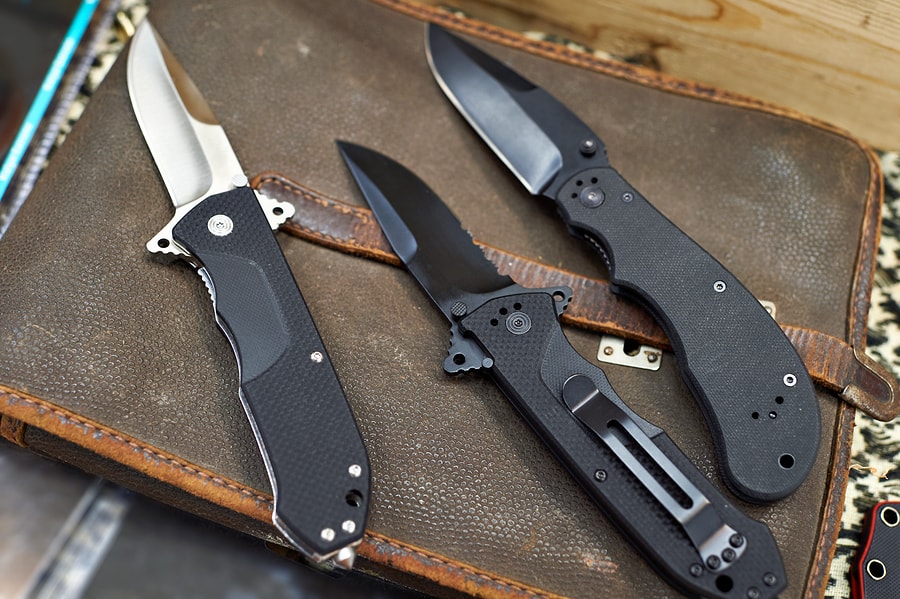Johnny Rambo, Crocodile Dundee, and Hannibal have one thing in common aside from being badass film characters – they each own a mean-looking survival knife.
However, not all of these knives garner high scores among survivalists and knife experts, particularly when it comes to actual, everyday use. Choosing the right survival knife takes more than just picking the coolest and meanest one there is. There are some factors you need to look at. Below are some points to ponder and examples you can check out before purchasing your own survival knife.

Knife Law
A survival knife is a good thing to have when you’re in a war-torn country or lost in the jungle. But if you’re in the city, you could get in trouble if you lug a ginormous bowie knife like Michael Myers in Halloween.

Laws on carrying knives differ from state to state but as a general rule, those with blades measuring more than 3 inches are illegal. Switchblades, butterfly knives, throwing knives, star knives, stilettos, and assisted opening knives are also banned in most states. A Swiss Army knife is legal. The same goes with utility knives, multi-tools, and other knives with 2.5-inch (or less) blades.

Knives are banned in schools, federal buildings, courts, planes, and military installations if you’re not in the military. However, even if you are carrying a small knife in places where they are allowed, you may still get in trouble with the law if you brandish it like a weapon.

You need a conceal carry to bring your survival knife with you. It should have also been acquired legally. If you are carrying a survival knife, you need to inform a police officer whenever one stops you.
Fixed Blade vs Folding Knives
After considering the knife laws in your state, you need to decide on getting a survival knife with a fixed blade or one that folds. Knife experts will readily tell you that a fixed blade is your best option mainly because it’s sturdier and safer than folding knives. Not all folding knives have reliable locking mechanisms. Additionally, you may find it difficult to operate a folding knife during a life-and-death situation.

Another advantage of fixed blades over folding knives is that the latter’s handle can be hollow. A hollow handle can be used to store other survival gear such as waterproof matches, magnesium firestarter, fish hooks, sewing kit, and/or medications. Some survival knives have a compass on the lid or tip of the handle. Others have paracord wrapped around the handle.

Perhaps the best argument for pro-folding knives is that they are easy to conceal and more compact. This is why some people count folding knives among their everyday carry (EDC).
Size of Survival Knife
Since we’re mainly talking of a survival knife, we’ll consider the best ones to bring to an outdoor adventure or keep among your preps and not the ones you’d take with you every day for self-defense.

Choosing a survival knife will depend mainly on what you are using it for. A knife with a larger, preferably fixed blade is a good thing to have when you’re on a camping trip or some kind of expedition in a place with lots of trees and dense vegetation. Larger knives are best used in the jungle or forest where you may need to cut some trees or large branches. If you’re going to the desert, a smaller knife or the folding ones will be enough.
Blade Material
There are two main materials used in making knives – carbon steel and stainless steel. Carbon steel is the material of choice for large fixed blade knives. The problem with this is that it rusts easily. This is remedied by coating or giving the blade a mirror polish. Stainless steel, meanwhile, is usually used on smaller blades.

If you prefer your knife to stay sharp for a long time, go for the carbon steel blade. If price is an issue, the stainless steel blade is cheaper but goes dull easier. The stainless steel blade is also easier to resharpen.
Blade Grind
There are different kinds of blade grind including flat, high flat, v-grind, convex, compound, and asymmetrical grind. When it comes to survival knives, the best ones are the saber and flat grinds. The primary bevel of the saber grind allows the blade to do some chopping and splitting while a full flat grind is great for slicing and is preferred for doing kitchen duties. Flat grinds are also used for whittling and woodworking.

Tang
Tang is not just a brand of juice. It’s also the piece of the blade that extends into the handle. This is an important part of the blade and a vital factor in choosing your own survival knife.

Experts prefer a knife with a full tang, which runs through the whole handle. A knife with a partial tang is prone to wiggling and may even fall off completely after strenuous and repeated use. The problem with a full tang knife is that it’s more expensive.
Grip/Handle
Get a feel for the knife by holding it. Some knives, particularly their handles, can be too huge for too for your hands. Make sure it feels good in your hands before buying it. A proper and secure grip has no or minimal gaps between the fingertips and the mount of Venus or the palm’s fleshy part. You may drop your knife or hurt yourself when using it if you can’t grip it properly. Also, try opening a folding knife to see if it’s easy to do so. You’ll need one that can be readily used when you need to defend yourself.

A survival knife is not solely for saving your life from people out to do you harm. These tools will also help you survive most emergency situations. You can use knives to cut branches and make tinder to start a fire so you can stay warm, cook food or boil water. A survival knife can also cut ropes or vines you need to build a shelter or a raft, in case you’re trapped on an island. You can also fish, hunt wild animals, or open canned goods with knives so you won’t die of hunger. In other words, a survival knife helps you survive. Plain and simple.
Just a disclaimer – We have partnered with these companies because we use their products and/or proudly trust and endorse them – so we do receive a commission if you make a purchase or sign up for services. Often, we are able to negotiate special discounts and/or bonuses, which we will pass on to you via our links. We often get short notice on sale items available for 24-48 hours as we will pass these savings onto you.
























